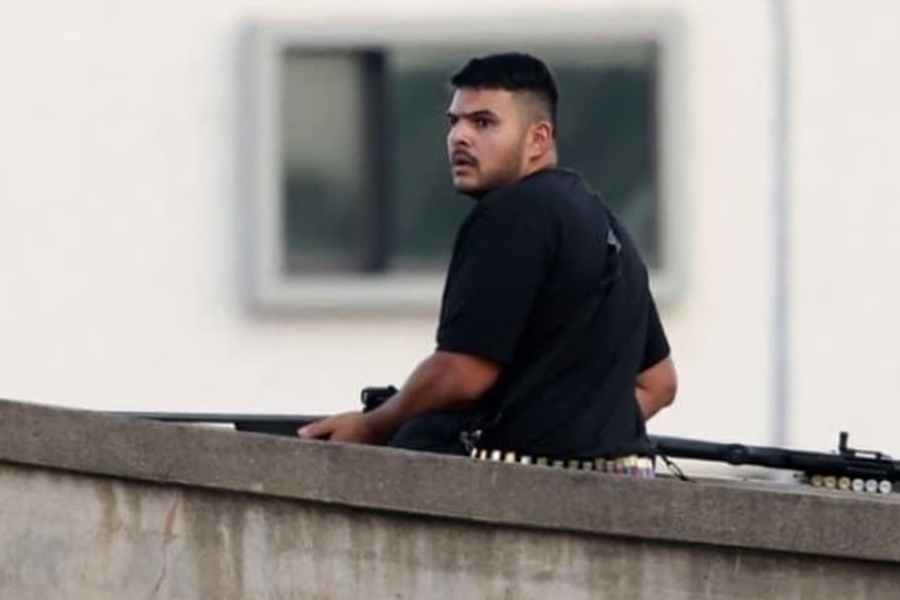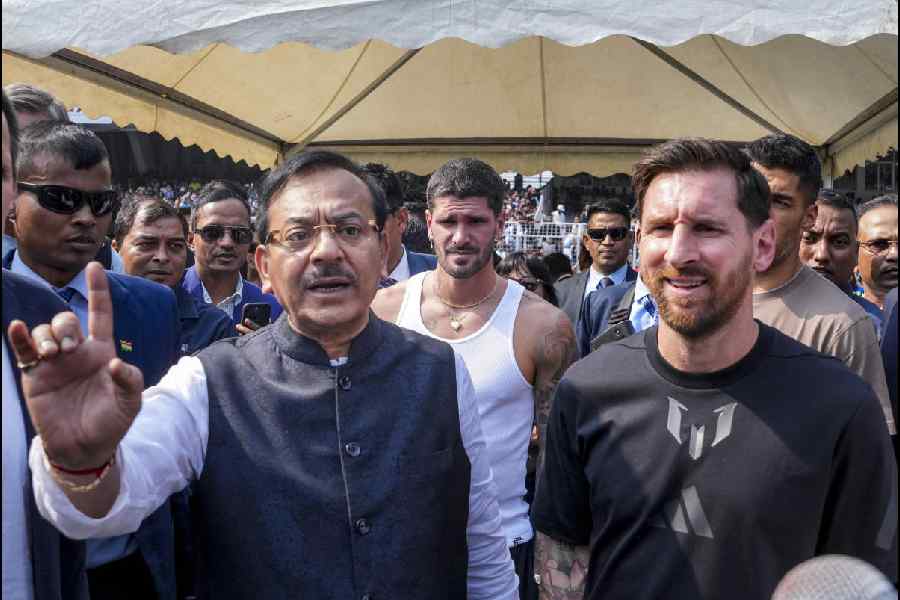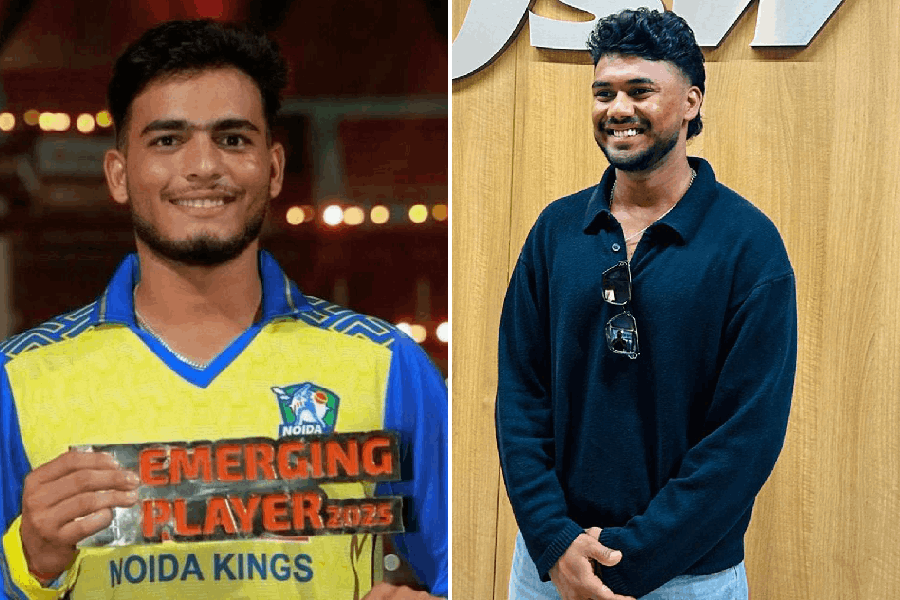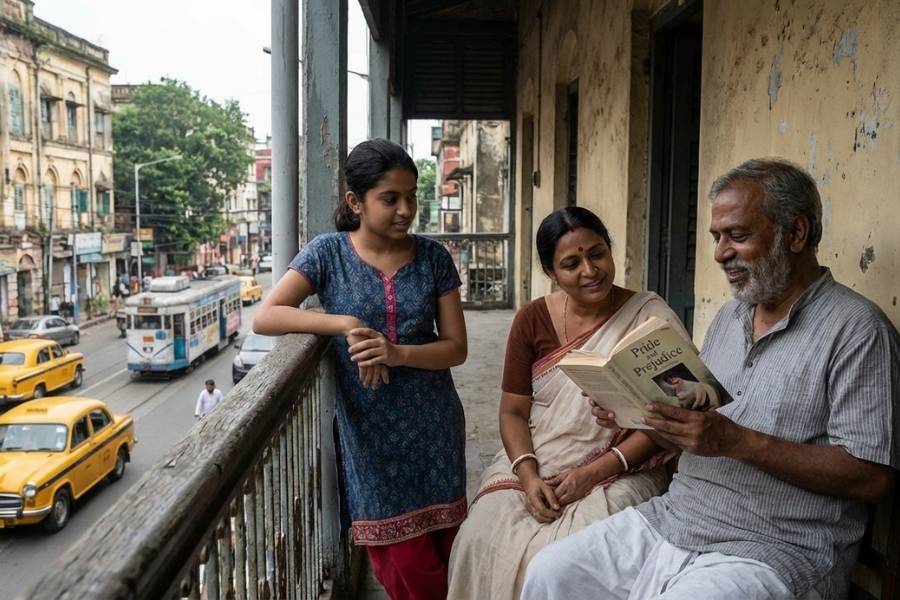 |  |
| ( Lleft) Monks from Belur Math arrive by boat at Ramkrishnapur ghat and (right) sing while walking to Nabagopal Ghosh’s house. Pictures by Anup Bhattacharya | |
February 6, 1898: A boat from Alambazar in Calcutta, anchored at Ramkrishnapur ghat in Howrah on the morning of Maghi Purnima. A bare-footed Swami Vivekananda, in his flowing saffron robe and turban, stepped on to the ghat. Along with him were other sannyasins. As people gathered to see the young monk who had returned from the West, Swami Vivekananda played a khol hanging around his neck and sung, ‘Ke re ore digambara’ (Who art thou laid on the lap of a poor Brahmin mother). Others joined him in chorus and the sannyasins danced in a procession from the ghat to Nabagopal Ghosh’s house in Ramkrishnapur. After reaching the house, Swamiji made his way to the temple in the house. It had a marble floor and in the centre was a throne on which Sri Ramakrishna’s porcelain mural was seated. Swamiji had brought this mural made from Berlin and had gifted it to Nabagopal Ghosh. As Swamiji spoke highly of the arrangements made by Ghosh, Nistarini Devi, Nabagopal’s wife, replied that this was a humble effort made by a poor man. ‘In reply to this, Swamiji jocosely said, “Your Thakur never had in his fourteen generations such a marble floored house to live in! He had his birth in that rural thatched cottage and lived his days on indifferent means. And if he does not live here so excellently served, where else should he live?” Swamiji’s words made everybody laugh out.’ (Quoted from The Complete Works of Swami Vivekananda, Vol 6). Swamiji then performed a puja in front of Sri Ramakrishna’s mural with Swami Prakashananda assisting him. At the end of the prayers, the monk composed the pranam mantra of Sri Ramakrishna that is chanted by devotees of Ramakrishna Mission till date.
 |
| Arati at the temple. Picture by Anup Bhattacharya |
February 25, 2013: It is the 115th anniversary of Swamiji’s visit to Nabagopal Ghosh’s house. The events that had happened 115 years ago were replayed. Two boats carrying sannyasins from Belur Math anchored at Ramkrishnapur ghat on the morning of Maghi Purnima and a group of 70 monks stepped on to the ghat led by senior monk, Swami Shivamayananda. Following the example that Swamiji had set in 1898, the monks walked, danced and sang the same song in a procession to Nabagopal Ghosh’s house. After reaching the house, Swami Vitakamananda performed puja at the temple where the same mural of Sri Ramakrishna is still seated on the throne that Swamiji had installed. The monks spent the day singing songs at the house. Thousands of devotees, who gathered at Nabagopal Ghosh’s house on this day were treated to a sumptuous meal of khichuri. This ritual is being followed every year since 1898, keeping Swami Vivekananda’s tradition alive.
Nabagopal Ghosh was a householder devotee of Sri Ramakrishna. He was the chief accountant of George Henderson, a merchant firm. It was by chance that he went to see Sri Ramakrishna at Dakshineswar with a colleague. He did not revisit till after two years, when Sri Ramakrishna asked for him. Since then, he became a frequent visitor to Dakshineswar with his family. Initially a resident of Badurbagan near Rajabazar, Nabagopal had often arranged for entertaining Sri Ramakrishna at his house. Many of these incidents are recorded in Sri Ramakrishna Kathamrita and other books. On one such occasion, Nistarini Devi, it is said, had fainted upon serving Sri Ramakrishna some sweets.
In 1890, Nabagopal shifted to a new house in Ramkrishnapur and had requested Swamiji to install an image of Sri Ramakrishna at his home. “This house was frequented by monks of the Ramakrishna order at that time. In those days, Ramakrishna Mission and its activities were not that well-known. Swami Vivekananda, too, was not such a household name as he is today,” said Subrata Ghosh, great grandson of Nabagopal Ghosh.
Today, the house is a treasure trove of facts and exhibits associated with the Ramakrishna Movement. The living room has a piano that dates back to Nabagopal Ghosh’s days. “Swamiji and other monks would play this piano and sing when he came to this house. Innumerable discussions and musical sessions have taken place here, in this room,” said Subrata standing on a wooden dais that covers most of the room. Oil paintings of Swami Vivekananda, Sri Ramakrishna and Sarada Devi adorn the walls of this room. “Nabagopal Ghosh’s second son had left the house and became a sannyasin, Swami Ambikananda. He had painted Sri Ramakrishna,” said Subrata. Nabagopal Ghosh’s other sons owned a colliery in Ranigunge called Shalimar Coal Company. However, a devastating fire destroyed the mine.
 | |
 |  |
 | |
| (From top) Maharajer ghar at the Ghosh residence, Swamiji’s turban, the Miller & Co harmonium and the mural of Sri Ramakrishna installed by Swamiji | |
The temple where Sri Ramakrishna’s mural is worshipped is on the terrace. “The chapel where Swamiji had installed the mural was on the first floor of the house. At that time, this room was being built. It was made from the same marble that was used to make Victoria Memorial,” said Subrata. The room is well maintained. The porcelain mural has a silver frame around it but there is no glass. “One can feel the etching on the porcelain. Jabakusum oil is rubbed on the image before it is bathed every day, just like people do before taking a bath and there is no sign of damage on the mural.
This practice is being followed for the past 116 years,” said Subrata. The family also possesses Swami Vivekananda’s silk turban that he wore when he went to Chicago. It has been with the family since Nabagopal Ghosh’s days. Preserved in a glass case, it is not shown to public. “We take it out for public viewing only on Maghi Purnima,” said Subrata. A separate room on the terrace is called ‘maharaj-er ghar’ where many ailing monks of the Ramakrishna order would come to take rest. “Ramakrishna Seva Pratisthan was not established at that time and ailing monks would have to be nursed somewhere. There were three places where they would stay and this house was one among them,” said Subrata. Sarada Devi had often visited the house and when she did, she stayed in this room. Local devotees would come and offer gul (a creamy snuff) to her. The four poster bed is considered holy and is covered with a saffron bed sheet. A painting of Swami Ambikananda rests on it. An old Miller & Co. harmonium lies in one corner of the room. “‘Khandana bhaba bhandhana’, the hymn sung during arati at the centres of the Ramakrishna Mission, was composed on this harmonium,” said Subrata.
While discussing about his family’s close association with Ramakrishna Mission, Subrata showed a rare Lalique crystal plaque with a figure of Swami Vivekananda as parivrajak (wanderer) engraved in it. “There are only four pieces of this crystal in the world and one of them is this one,” he said proudly.











